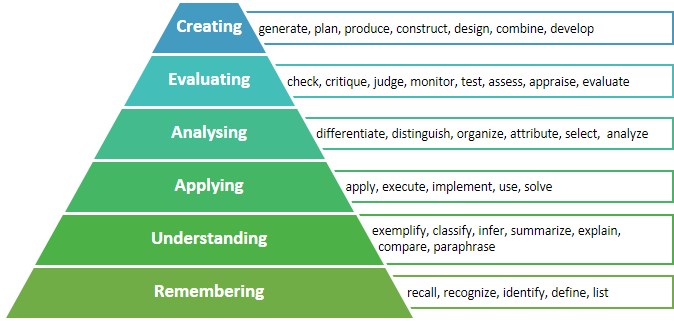Guidelines for Producing Effective ILO Statements
Choosing appropriate and measurable action verbs
Bloom’s Taxonomy can help in identifying appropriate action verbs in ILO statements. Bloom specified six levels of cognitive learning namely: Remembering, Understanding, Applying, Analyzing, Evaluating and Creating (From Level 1-6). You can use Bloom's taxonomy to identify verbs to describe student learning.

Alternatively, CEI has a quick tool to help you build the intended learning outcomes for your course, click CEI's Outcomes Syllabus Builder.
As you write your ILO statements, always think about how you might assess them and are these outcomes achievable for your students. There are some vague verbs that we need to avoid in writing our learning outcomes. Some vague verbs such as “know” or “understand” are not observable and measurable. Instead, they should be substituted with performative verbs such as “identify”, “define”, “describe” or “demonstrate”.
To help instructors with their course design process, Rex Heer at Iowa State University has produced an excellent 3D representation of Anderson's et al's 2001 revision of Bloom et al's 1956 Taxonomy of Cognitive Learning Outcomes which can also be downloaded as a pdf file here.
Linking ILOs with teaching and assessment: constructive alignment
ILOs should be part of the curriculum design and teaching. John Biggs called the integration of outcomes with both teaching and assessment as “constructive alignment”. There are two parts in constructive alignment:
-
Constructive: what students do to construct meaning from what they learn.
-
Alignment: what teachers do to align the teaching methods, the learning activities provided and the assessment tasks set with the intended outcomes. There also needs to be vertical alignment between learning outcomes at the course, program, school, common core and institutional levels* (see Aligning learning outcomes at different levels below) to ensure a cohesive and integrated curriculum.
Aligning learning outcomes at different levels
When writing the course’s ILOs, it is important to put them in line with the department’s, program’s, school’s, common core’s and university’s ILOs. It might not be possible for your course to link with all ILOs of the Program’s or department’s. But it has to be linked or related to at least one. Some courses will be associated with more than one objectives.
Key Questions to ask when writing outcome statements:
- Is what I want my students to be able to do clearly defined?
- Have I thought about the type and level of this particular outcome, and its relationship to other outcomes?
- Will I be able to show credible evidence that this outcome is achieved and, if so, how?
- Is this outcome written on the basis of a learning perspective, instead of a teaching perspective?
- Will I be able to design a learning experience that will actually deliver this outcome?
References:
Bloom, B. S. (ed.). Taxonomy of Educational Objectives. Vol. 1: Cognitive Domain. New York: McKay, 1956
![]()
A Model of Learning Objectives–based on A Taxonomy for Learning, Teaching, and Assessing: A Revision of Bloom's Taxonomy of Educational Objectives by Rex Heer, Center for Excellence in Learning and Teaching, Iowa State University is licensed under a Creative Commons Attribution-NonCommercial-ShareAlike 3.0 Unported License.
Anderson, L.W. (Ed.), Krathwohl, D.R. (Ed.), Airasian, P.W., Cruikshank, K.A., Mayer, R.E., Pintrich, P.R., Raths, J., & Wittrock, M.C. (2001). A taxonomy for learning, teaching, and assessing: A revision of Bloom’s Taxonomy of Educational Objectives (Complete edition). New York: Longman.
- 12004 reads
